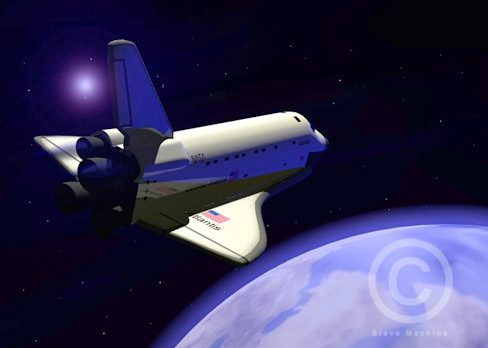Space Shuttle Discovery (Orbiter Vehicle Designation: OV-103) is one of the orbiters in the Space Shuttle fleet of NASA, the space agency of the United States., operating from 1984 until 2011. When first flown in 1984, Discovery became the third operational orbiter, and it made its final landing on 9 March 2011 at 10:57:17 CST,, with a cumulative total of one full year (365 days) in space. Discovery has performed both research and International Space Station (ISS) assembly missions.
Two orbiters, Atlantis and Endeavour, remain operational.
Others include
Had the planned STS-62-A mission from Vandenberg Air Force Base in 1986 for the United States Department of Defense gone ahead, Discovery would have flown it.
Beginning in the fall of 1995, the orbiter underwent a nine-month Orbiter Maintenance Down Period (OMDP) in Palmdale California. The vehicle was outfitted with a 5th set of cryogenic tanks and an external airlock to support missions to the International Space Station. It returned to the Kennedy Space Center, riding piggy-back on a modified Boeing 747, in June 1996.
Following STS-105, Discovery became the first of the orbiter fleet to undergo Orbiter Major Modification (OMM) period at the Kennedy Space Center. Work began in September 2002, and along with the scheduled upgrades, additional safety modifications were added as part of the preparations for Return to Flight.
Most important missions:
NASA has offered Discovery to the Smithsonian Institution's National Air and Space Museum for public display and preservation as part of the national collection after the orbiter has been retired.Discovery will replace Space Shuttle Enterprise in the Smithsonian's display at the Steven F. Udvar-Hazy Center.
Two orbiters, Atlantis and Endeavour, remain operational.
History
The spacecraft takes its name from four British ships of exploration named Discovery, primarily HMS Discovery, one of the ships commanded by Captain James Cook during his third and final major voyage, 1776–1779.Others include
- Henry Hudson's Discovery, which he used in 1610–1611 to search for a Northwest Passage;
- HMS Discovery, one of the ships which took Captain George Nares' British Arctic Expedition of 1875–1876 to the North Pole; and
- RRS Discovery, a Royal Geographical Society research vessel which, under the command of Captain Robert Falcon Scott and Ernest Shackleton, was the main ship of the 1901–1904 "Discovery Expedition" to Antarcticawhich is still preserved as a museum.
Had the planned STS-62-A mission from Vandenberg Air Force Base in 1986 for the United States Department of Defense gone ahead, Discovery would have flown it.
Upgrades and features
Discovery benefited from lessons learned in the construction and testing of Enterprise, Columbia and Challenger. At rollout, its weight was some 6,870 pounds less than Columbia.Beginning in the fall of 1995, the orbiter underwent a nine-month Orbiter Maintenance Down Period (OMDP) in Palmdale California. The vehicle was outfitted with a 5th set of cryogenic tanks and an external airlock to support missions to the International Space Station. It returned to the Kennedy Space Center, riding piggy-back on a modified Boeing 747, in June 1996.
Following STS-105, Discovery became the first of the orbiter fleet to undergo Orbiter Major Modification (OMM) period at the Kennedy Space Center. Work began in September 2002, and along with the scheduled upgrades, additional safety modifications were added as part of the preparations for Return to Flight.
Flights
Discovery has flown 148 million miles in 39 flights, completed 5,247 orbits, and spent 322 days in orbit over 27 years. After Discovery's STS-133 mission, the Orbiter has flown 39 flights to space. Discovery is the orbiter fleet leader, having flown more flights than any other orbiter in the fleet, including four in 1985 alone. Discovery flew all three "return to flight" missions after the Challenger and Columbia disasters: STS-26 in 1988, STS-114 in 2005, and STS-121 in 2006. Discovery flew the third to last space shuttle mission STS-133, having launched on (NET) Feb. 24, 2011. Endeavour will be the next shuttle to fly aboard STS-134 and Atlantis will be NASA's last Space Shuttle mission to be launched aboard STS-135 mission. Discovery safely completed its final mission on March 9, 2011.Most important missions:
- STS-41-D: First flight
- STS-51-D: Carried first incumbent United States member of Congress into space, Senator Jake Garn (R–Utah)
- STS-26: Return to space after Challenger disaster (STS-51-L)
- STS-31: Launch of Hubble Space Telescope
- STS-60: First Russian launched in an American spacecraft (Sergei Krikalev)
- STS-95: Second flight of John Glenn, oldest man in space and third incumbent member of Congress to enter space
- STS-96: First flight to dock to the International Space Station
- STS-92: The 100th Space Shuttle mission
- STS-114: Return to space after Columbia disaster (STS-107)
- STS-116: First night time launch of a shuttle since the Columbia disaster. Last Shuttle launch from LC-39B
- STS-131: Longest mission for this orbiter
- STS-133: Final mission for this orbiter
Planned decommissioning
Discovery will be decommissioned in 2011. Following Discovery's landing on Kennedy Space Center, Florida on March 9, the OV-103 is to be decommissioned.NASA has offered Discovery to the Smithsonian Institution's National Air and Space Museum for public display and preservation as part of the national collection after the orbiter has been retired.Discovery will replace Space Shuttle Enterprise in the Smithsonian's display at the Steven F. Udvar-Hazy Center.




 Posted in:
Posted in: 



